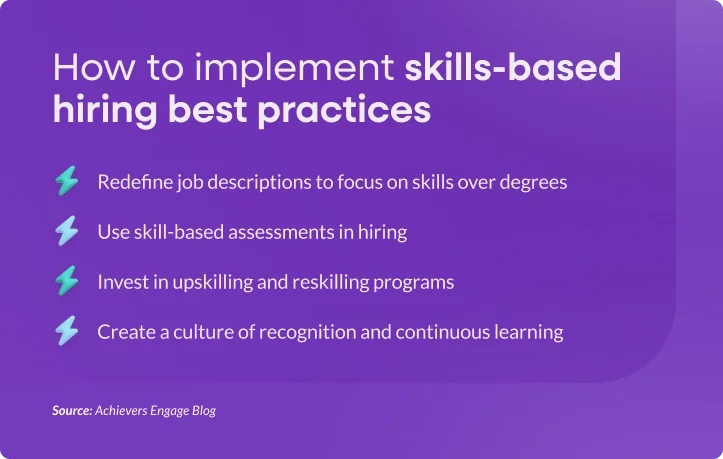Table of contents
The way companies hire is changing. More and more organizations are moving away from strict degree requirements and focusing on what really matters — skills and abilities. This approach, known as skills-based hiring, prioritizes what candidates can do over where they went to school or their job titles.
And the shift is happening fast. A recent survey found that 81% of companies worldwide adopted skills-based hiring in 2024, up from 73% in 2023 and just 56% in 2022. Another report shows that nearly two-thirds of employers use skills-based hiring for entry-level positions.
By focusing on skills, companies can tap into a wider, more diverse talent pool and find the best people for the job — regardless of their background. As businesses look to stay competitive and innovative, skills-based hiring is proving to be the future of talent acquisition.
Why skills-based hiring is gaining traction
Skills-based hiring is on the rise as companies adapt to a rapidly changing job market. Here’s why more organizations are embracing this approach:
The demand for diverse, adaptable talent
Today’s workforce is more dynamic than ever, and businesses need employees who can quickly learn and adapt. Skills-based hiring helps companies tap into a broader talent pool, including career changers, self-taught professionals, and those from nontraditional backgrounds. This approach also supports workplace diversity by removing unnecessary barriers to entry.
Addressing skills gaps with continuous learning
Industries across the board are facing growing skills gaps, making it harder to find talent with the right expertise. Rather than focusing on degrees, companies are prioritizing practical skills and ongoing development. By hiring for ability and potential, organizations can future-proof their workforce and encourage continuous learning.
AI and automation are reshaping job requirements
The rise of AI and automation is transforming the skills employers need. Many traditional roles are evolving, requiring employees to develop new technical and problem-solving skills. Skills-based hiring ensures that companies focus on what truly matters — whether candidates can perform the job today and adapt for the future.
Benefits of skills-based hiring
Shifting the focus from degrees to skills isn’t just a hiring trend — it’s a smarter way to build stronger, more inclusive teams. Here’s how skills-based hiring benefits both employers and employees:
- Improves workforce diversity: By removing unnecessary degree requirements, companies can attract talent from a wider range of backgrounds. This approach levels the playing field, giving opportunities to skilled individuals who may have taken nontraditional career paths.
- Expands the talent pool: Skills-based hiring helps businesses find qualified candidates faster. Instead of filtering out applicants based on formal education, companies can focus on real-world abilities, making it easier to fill critical roles in competitive job markets.
- Enhances job performance: When employees are hired based on their competencies rather than credentials, they’re more likely to succeed in their roles. Employers get talent that’s proven to perform, rather than just meeting traditional hiring criteria.
- Boosts retention and engagement: Employees who are recognized for their skills — not just their past job titles — feel more valued and empowered. This leads to higher job satisfaction, stronger employee engagement, and lower turnover rates.

How to implement skills-based hiring best practices
To successfully transition to a skills-based hiring approach, organizations need to rethink traditional hiring methods and foster a culture that values competencies over credentials.
Here are four key steps to implementing skills-based hiring effectively:
1. Redefine job descriptions to focus on skills over degrees
Many job descriptions prioritize degrees and years of experience rather than the actual skills required for success. To attract a broader, more qualified talent pool:
- Identify the core competencies needed for the position
- Remove unnecessary degree requirements unless legally required
- Use clear, skill-based language in job postings to reach diverse candidates
2. Use skill-based assessments in hiring
Resumes and interviews don’t always showcase a candidate’s true abilities. Instead, skill-based assessments offer a more accurate measure of potential by:
- Incorporating real-world tasks, case studies, or simulations into the hiring process
- Leveraging AI-driven assessments to evaluate problem-solving and technical skills
- Prioritizing demonstrated abilities over credentials to ensure job readiness
3. Invest in upskilling and reskilling programs
Skills-based hiring isn’t just about finding the right talent — it’s about continuous development to keep pace with industry demands. Organizations can:
- Offer training programs, certifications, and mentorship opportunities
- Support internal mobility by helping employees transition into new roles
- Use learning management systems (LMS) and microlearning tools for ongoing development
4. Create a culture of recognition and continuous learning
To make skills-based hiring truly effective, companies must foster an environment where learning and development are encouraged and rewarded:
- Recognize employees for skill development and achievements through platforms like Achievers Recognize™
- Encourage peer recognition for learning and growth
- Use engagement tools like Achievers Listen™ to gather feedback on training needs and career growth opportunities
How Achievers supports skills-based hiring and retention
Implementing a skills-based hiring approach is just the beginning — organizations also need to nurture and retain top talent by fostering a culture of continuous learning and recognition. Achievers provides the tools to support this shift, ensuring employees feel valued for their skills and contributions.
- Recognizing and rewarding skill development: Achievers Recognize™ reinforces a learning culture by celebrating employees who acquire new skills, motivating continuous growth.
- Fostering engagement and belonging: Employees who feel valued for their abilities, rather than just their job titles, are more engaged and committed, reducing turnover.
- Driving continuous learning: Achievers Listen™ helps HR teams track employee feedback on growth opportunities, ensuring development initiatives align with workforce needs.
- Strengthening internal mobility: Recognition data highlights high-potential employees, making it easier to identify talent for promotions and lateral moves.
Future-proof your workforce with skills-based hiring
Focusing on skills rather than credentials is becoming essential for building a strong, adaptable workforce. As industries evolve and skills gaps widen, companies that prioritize competencies will be better positioned to attract top talent, drive performance, and stay competitive. Shifting to a skills-based hiring model helps create a more diverse and capable workforce while ensuring employees are set up for long-term success.
To make the most of this approach, organizations should invest in recognition programs and engagement tools that support continuous learning. Platforms like Achievers Recognize™ and Achievers Listen™ help reinforce skill development by celebrating achievements and gathering employee feedback on growth opportunities. Prioritizing skills today ensures your workforce is ready for the challenges of tomorrow. Now is the time to embrace skills-based hiring and build a team equipped for the future.



